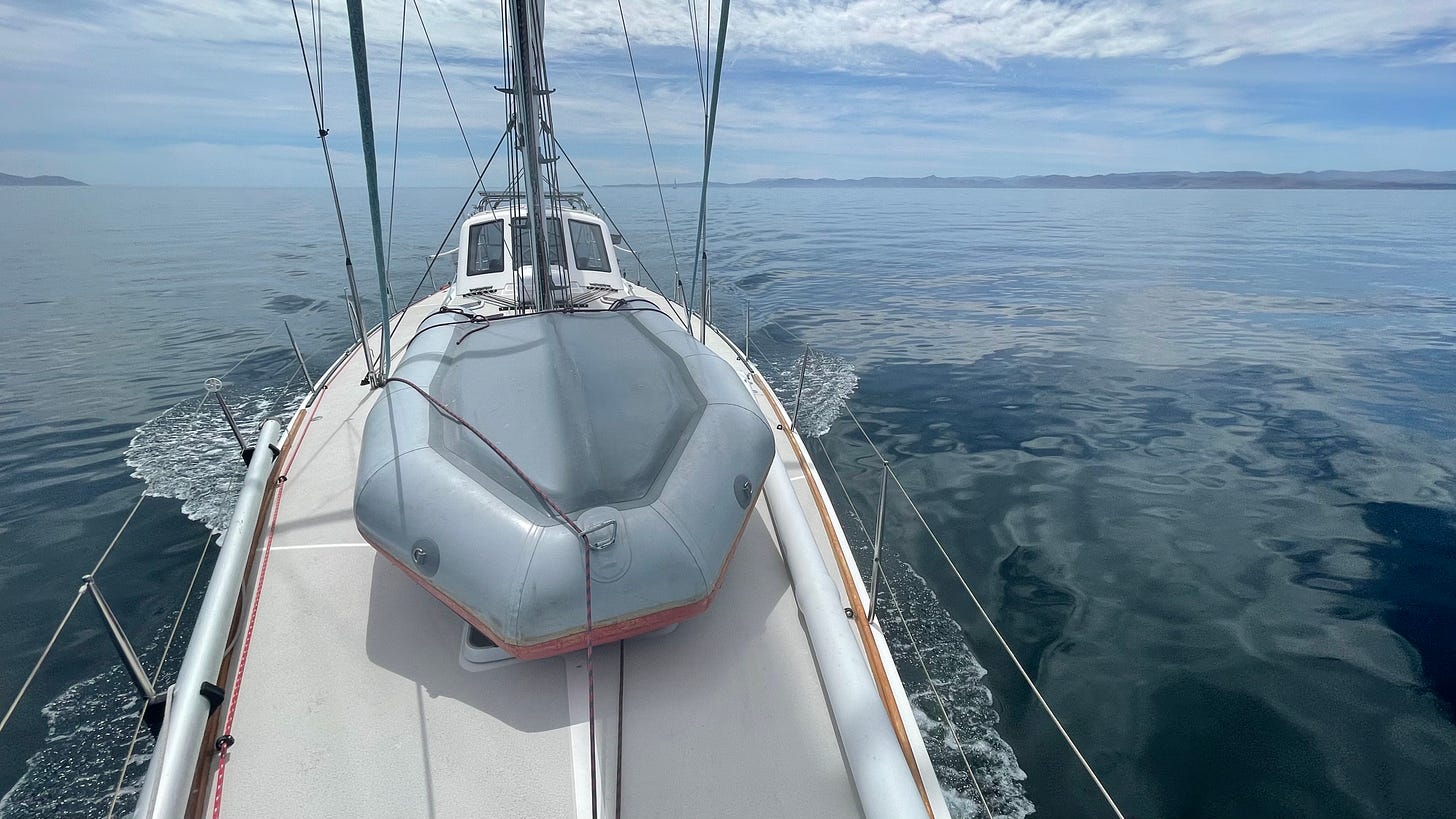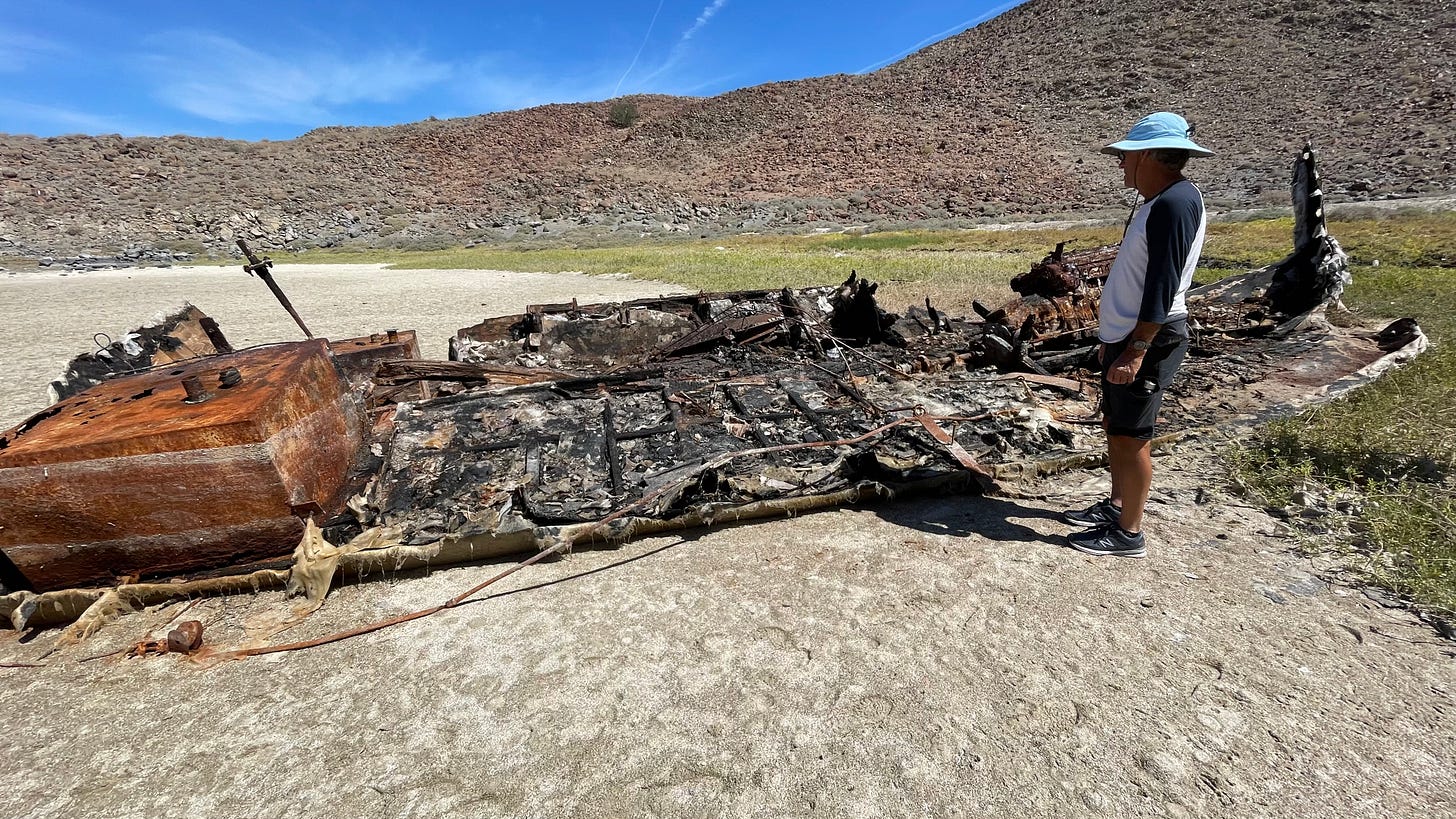San Francisquito and San Juan
Birds and bones and a hike, oh my!
Our sail from Santa Rosalía was about seventy five nautical miles, or roughly ten hours. To ensure we weren’t approaching the harbor and anchoring in the dark, we left early enough to drop anchor by about five o’clock in the afternoon. The day was long, but we nearly always had another boat in sight, as K2, Fundango, and Rochambeau all came along. Triæna and Via had parted company the day before to head across the Sea together. After a long day on the water, after getting together on Rochambeau for drinks, we all headed back to our respective boats for a good night’s sleep.
Due to incoming weather, and the exposed nature of the San Francisquito anchorage, we didn’t get to spend much time. Having a day off occasionally is important, as it’s easy to get too swept up in hiking, snorkeling, and moving the boat. Everything takes work, and everyday is the weekend, so it’s easy to miss out on down time. This was such a gorgeous anchorage though, especially considering that the weather was super calm while we were there.
First thing the next morning, we set off on another fifty mile sail to hole up in Puerto Don Juan, one of the most protected anchorages in the northern sea. There was minimal wind in the morning, so we ended up motoring through the Canal de Salsipuedes, which means “get out if you can,” but as the day wore on, the wind slowly picked up, and we were able to sail a bit.
Eventually, we made our way up to Puerto Don Juan. The approach was super interesting for us, because unlike most anchorages we had been seeing, Don Juan has a crooked channel, with a dog leg to the right, and then a dog leg to the left, leading to an almost completely sheltered little bay, mostly surrounded by mountains, with a small window to the west, and a long tidal flat to the east. When we arrived, this flat was completely submerged, but as the tide went out, the broad sand flat emerged, with clams scattered about.
Waking up early the morning after our arrival, we were surprised to see an interesting phenomenon: a flock of aquatic birds, all swimming in a close circle as they wandered to and fro in the anchorage, in between our boats. At a certain point, one bird would pop a few inches out of the water to better dive under the surface, and start the others diving like dominos falling. Eventually, the entire flock would disappear underwater. After a surprisingly long time, often several minutes, one bird would pop back to the surface some distance from where the flock had disappeared, and one by one, the others would pop up around that first bird to appear, until the whole flock was swimming along the surface as if nothing had happened.
One morning, we all headed in to shore while the tide was out. Everyone wandered around looking at various things on the beach, while Brian and I started picking up the clams. One in each hand, and smack together as hard as you can. One shell breaks, and you can eat the tender little morsel inside. These were butter clams, with small white shells, and the small tan foot inside each was tender and a little briny. Brian and I walked around eating these, and offering them to others. The best part is that none of these came with any warning about the consumption of raw or undercooked shellfish! At any rate, no people were harmed in the eating of these clams, so all’s well that ends well, although the some of those clams probably weren’t very happy.
In the afternoon, Donna and a few folks from the other boats decided to go for a walk onshore, but I decided to stay on the boat to enjoy some time and space by myself: one thing that we don’t get much of on the boat. It’s a small space, and we’re together all day, everyday, 24/7, so we need to give ourselves a break when we can. So Donna went for a hike, with Brian and Nancy from K2, John and Marcy from Rochambeau, and Joanne from Fundango. Scott opted to stay behind as well, as hiking isn’t really his bag.
Whenever we go hiking, there’s always a process of taking the dinghy to shore, landing at the beach, and pulling it up out of the water. Since you’re often stepping in the water to do this, generally you don’t want to wear your hiking shoes, so you just throw them in the boat. But once. you get the boat pulled up, and you want to put your shoes and socks on, you’ve got to get all the sand off your feet. When we have our act together, we’ll bring an extra towel or rag to help with this, and when we don’t we just have sand between our toes all day. If you want to cruise, you have to pay the price.
The hike from Puerto Don Juan heads east across a peninsula separating the bay from the next bay over. Hiking along the Baja may reveal many unique and interesting finds, from abandoned resort hotels, to old cemeteries, to boats that have washed ashore and nearly completely disintegrated. Wherever you go, though, there are always the plants.
Baja is a surprisingly lush desert, with many green plants adapted to the extreme aridity, and lots of flowers blooming throughout the winter. Everything is still very sparse and well adapted to the dryness of the desert, so the flowers are often small, as are any leaves, with several species of cactus mixed in just to drive the point home that this isn’t the most hospitable place for a garden.
The walk across the peninsula wasn’t very long, with a beautiful, sweeping beach on the other side, covered with fist-sized stones smoothed by the tumbling surf. These deserted beaches often show signs of the natural life in the Sea, as well, with bones from fish, whales, and often big horn sheep or goats as well. Usually, they’ve been completely sun bleached by the time we find them.
Surprisingly, we don’t find as much trash laying around as you might expect. The beaches aren’t completely drifted with tangled nets and detergent bottle flotsam, as you might expect by the amount of trash in the deserts around the towns. We do what we can to clean up and help keep these places beautiful and pristine, but it’s hard, knowing that often if you take trash into the smaller towns, they’ll charge you to handle your trash, but then just throw it into a gully behind the town. As a result, we always try to store trash until we get to larger towns with more established dumps. Recycling is nearly unheard of in Baja, although occasionally you’ll run into someone who tries.
After a long hike, it’s always nice to see the boats floating in the anchorage, with your home floating among them. A quick swim, maybe a shower, and dinner await. Often a sundowner helps the day slip away, and as the stars come out and the darkness deepens, it’s off to bed early. Somehow the bright light sets your circadian rhythms, and nine o’clock seems like cruiser midnight, with full wakefulness popping in as the sun comes through the hatches at six in the morning, encouraging you to get up and do it all over again.












I just read a book, John F. Carlson’s “”Guide to Landscape Painting”. In the Clouds chapter he describes and shows his sketch of Cirrus clouds which he says are the most beautiful of all and most difficult to paint. Some formations are in “ heroic semi-circular sweeps called a mackerel sky”. Your photo of Salacia in Bahia San Francisquito is that sky! Mackerel sky was a new term for me sourced from the sailing world I think. Thanks for the beautiful shot and inspiration for a future painting.
Lovely ending.